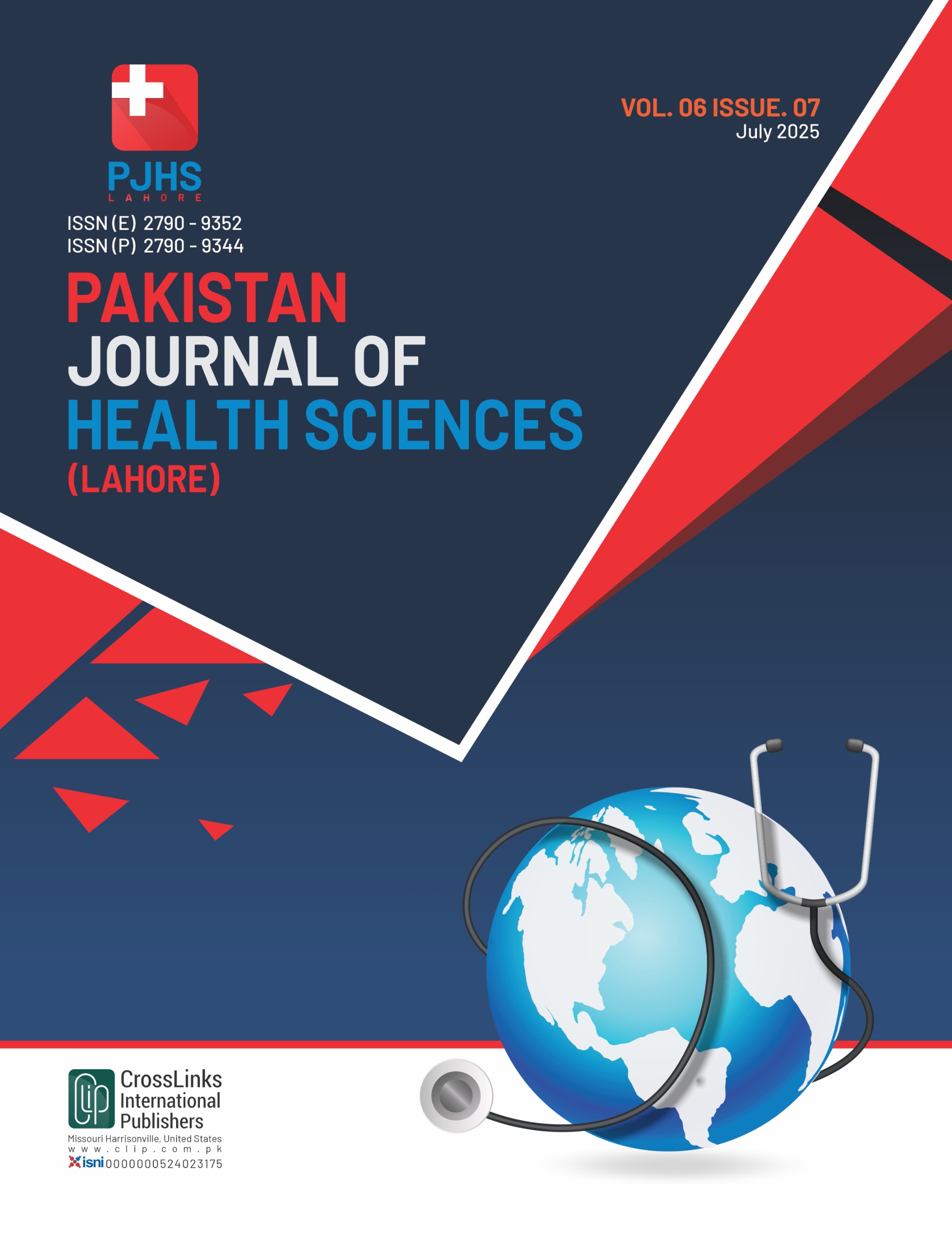Serum Adiponectin Levels and Their Association with Age, Gender and Waist Circumference: Insights from a Cross-Sectional Study
Serum Adiponectin Levels and Age, Gender, Waist Circumference
DOI:
https://doi.org/10.54393/pjhs.v6i7.3108Keywords:
Adiponectin, Age, Waist Circumference, Metabolic Health, Obesity, Insulin SensitivityAbstract
Adipose tissue secretes the adipokine adiponectin, which is essential for insulin sensitivity, cardiovascular health, and metabolic control. Although prior studies suggest that age and waist circumference (WC) influence adiponectin levels, contradictory results indicate the need for further research. Objectives: To evaluate and compare serum adiponectin levels among individuals of different age groups and waist circumference categories. Methods: A cross-sectional study was conducted with 50 individuals. Age, WC, body mass index (BMI), and gender were among the anthropometric information gathered. Spearman's correlation was used to test serum adiponectin levels and their relationships with these factors. The threshold for statistical significance was p<0.05. Results: The average amount of adiponectin in the blood was 5.59 ± 1.94 ng/mL. Adiponectin did not significantly correlate with either WC (r=+0.17, p=0.16) or age (r=-0.06, p=0.60). Furthermore, although somewhat higher in females, adiponectin levels did not significantly correlate with either gender (p=0.47) or BMI (r=+0.10, p=0.37). Conclusion: It was concluded that results show no significant relationships of adiponectin with WC, in contrast to previous research that found an inverse link with WC or an age-related increase in adiponectin. This could be the result of unmeasured confounding variables, including food and lifestyle, sample size restrictions, or demographic characteristics. More extensive research is needed to elucidate these connections and investigate adiponectin's potential as a biomarker for metabolic diseases.
References
Song Y, Zhou Y, Feng X, Fu J, Liu Y. The global death and disability burden associated with a high BMI in children and adolescents, 1990–2019. Frontiers in Endocrinology. 2024 Oct; 15: 1463002. doi: 10.3389/fendo.2024.1463002. DOI: https://doi.org/10.3389/fendo.2024.1463002
Ramakrishnan N, Auger K, Rahimi N, Jialal I. Biochemistry, adiponectin. In Stat Pearls [Internet]. 2023 Jul.
Zhang Y, Wei Y, Zheng T, Tao Y, Sun Y, Jiang D, Tao J. Adiponectin receptor 1-mediated stimulation of Cav3. 2 channels in trigeminal ganglion neurons induces nociceptive behaviors in mice. The Journal of Headache and Pain. 2023 Aug; 24(1): 117. doi: 10.1186/s10194-023-01658-2. DOI: https://doi.org/10.1186/s10194-023-01658-2
Khoramipour K, Chamari K, Hekmatikar AA, Ziyaiyan A, Taherkhani S, Elguindy NM et al. Adiponectin: structure, physiological functions, role in diseases, and effects of nutrition. Nutrients. 2021 Apr; 13(4): 1180. doi: 10.3390/nu13041180. DOI: https://doi.org/10.3390/nu13041180
Jiang T, Zhang Y, Dai F, Liu C, Hu H, Zhang Q. Advanced glycation end products and diabetes and other metabolic indicators. Diabetology and Metabolic Syndrome. 2022 Jul; 14(1): 104. doi: 10.1186/s13098-022-00873-2. DOI: https://doi.org/10.1186/s13098-022-00873-2
Park S and Shimokawa I. Influence of adipokines on metabolic dysfunction and aging. Biomedicines. 2024 Apr; 12(4): 873. doi: 10.3390/biomedicines12040873. DOI: https://doi.org/10.3390/biomedicines12040873
Smith E. Elucidating the role of age induced alterations in adipose tissue (Master's thesis, Boston University). 2021.
Lee YP, Chang CH, Chen CY, Wen CJ, Huang HL, Peng JK et al. Correlation between plasma ZAG and adiponectin in older adults: gender modification and frailty specificity. BioMed Central Geriatrics. 2021 Dec; 21: 1-0. doi: 10.1186/s12877-021-02379-4. DOI: https://doi.org/10.1186/s12877-021-02379-4
Muratsu J, Kamide K, Fujimoto T, Takeya Y, Sugimoto K, Taniyama Y et al. The combination of high levels of adiponectin and insulin resistance are affected by aging in non-obese old peoples. Frontiers in Endocrinology. 2022 Jan; 12: 805244. doi: 10.3389/fendo.2021.805244. DOI: https://doi.org/10.3389/fendo.2021.805244
Sasaki T, Nishimoto Y, Hirata T, Abe Y, Hirose N, Takayama M et al. Status and physiological significance of circulating adiponectin in the very old and centenarians: an observational study. Elife. 2023 Sep; 12: e86309. doi: 10.7554/eLife.86309. DOI: https://doi.org/10.7554/eLife.86309
Lubis DA and Lindarto D. The Correlation between Apolipoprotein B Levels and Inflammatory Markers in Obese Individuals. 2020. doi: 10.5220/0009858900640067. DOI: https://doi.org/10.5220/0009858900640067
Makarewicz A, Jamka M, Geltz J, Śmidowicz A, Kokot M, Kaczmarek N et al. Comparison of the effect of endurance, strength, and endurance-strength training on inflammatory markers and adipokines levels in overweight and obese adults: systematic review and meta-analysis of randomized trials. In Healthcare. 2022 Jun; 10(6): 1098. doi: 10.3390/healthcare10061098. DOI: https://doi.org/10.3390/healthcare10061098
Li N, Zhao S, Zhang Z, Zhu Y, Gliniak CM, Vishvanath L et al. Adiponectin preserves metabolic fitness during aging. Elife. 2021 Apr; 10: e65108. doi: 10.7554/eLife.65108. DOI: https://doi.org/10.7554/eLife.65108
Klobučar I, Habisch H, Klobučar L, Trbušić M, Pregartner G, Berghold A et al. Sex-related differences in the associations between adiponectin and serum lipoproteins in healthy subjects and patients with metabolic syndrome. Biomedicines. 2024 Sep; 12(9): 1972. doi: 10.3390/biomedicines12091972. DOI: https://doi.org/10.3390/biomedicines12091972
Zamboni M, Mazzali G, Brunelli A, Saatchi T, Urbani S, Giani A et al. The role of crosstalk between adipose cells and myocytes in the pathogenesis of sarcopenic obesity in the elderly. Cells. 2022 Oct; 11(21): 3361. doi: 10.3390/cells11213361. DOI: https://doi.org/10.3390/cells11213361
Adiyaman SC, Ozer M, Saydam BO, Akinci B. The role of adiponectin in maintaining metabolic homeostasis. Current Diabetes Reviews. 2020 Feb; 16(2): 95-103. doi: 10.2174/1573399815666190702155733. DOI: https://doi.org/10.2174/1573399815666190702155733
Palmgren H. Cell Membrane Homeostasis in Mammals-The roles of ADIPOR2 and TLCD1 and 2. 2022 May.
Mester P, Räth U, Schmid S, Müller M, Buechler C, Pavel V. Exploring the relationship between plasma adiponectin, gender, and underlying diseases in severe illness. Biomedicines. 2023 Dec; 11(12): 3287. doi: 10.3390/biomedicines11123287. DOI: https://doi.org/10.3390/biomedicines11123287
Al-Absi B, Al-Habori M, Saif-Ali R. Plasma Lipocalin-2 and adiponectin are affected by obesity rather than type 2 diabetes mellitus per se. Diabetes, Metabolic Syndrome and Obesity. 2021 Nov: 4547-56. doi: 10.2147/DMSO.S338254. DOI: https://doi.org/10.2147/DMSO.S338254
Koo BK and Lim S. Metabolic Syndrome and Metabolic Dysfunction‐Associated Fatty Liver Disease. Clinical Obesity in Adults and Children. 2022 Mar: 159-77. doi: 10.1002/9781119695257.ch13. DOI: https://doi.org/10.1002/9781119695257.ch13
de Luis D, Primo D, Izaola O, Gomez JJ. Relationship between adiponectin and muscle mass in patients with metabolic syndrome and obesity. Journal of Diabetes and Its Complications. 2024 Apr; 38(4): 108706. doi: 10.1016/j.jdiacomp.2024.108706. DOI: https://doi.org/10.1016/j.jdiacomp.2024.108706
Downloads
Published
How to Cite
Issue
Section
License
Copyright (c) 2025 Pakistan Journal of Health Sciences

This work is licensed under a Creative Commons Attribution 4.0 International License.
This is an open-access journal and all the published articles / items are distributed under the terms of the Creative Commons Attribution License, which permits unrestricted use, distribution, and reproduction in any medium, provided the original author and source are credited. For comments













